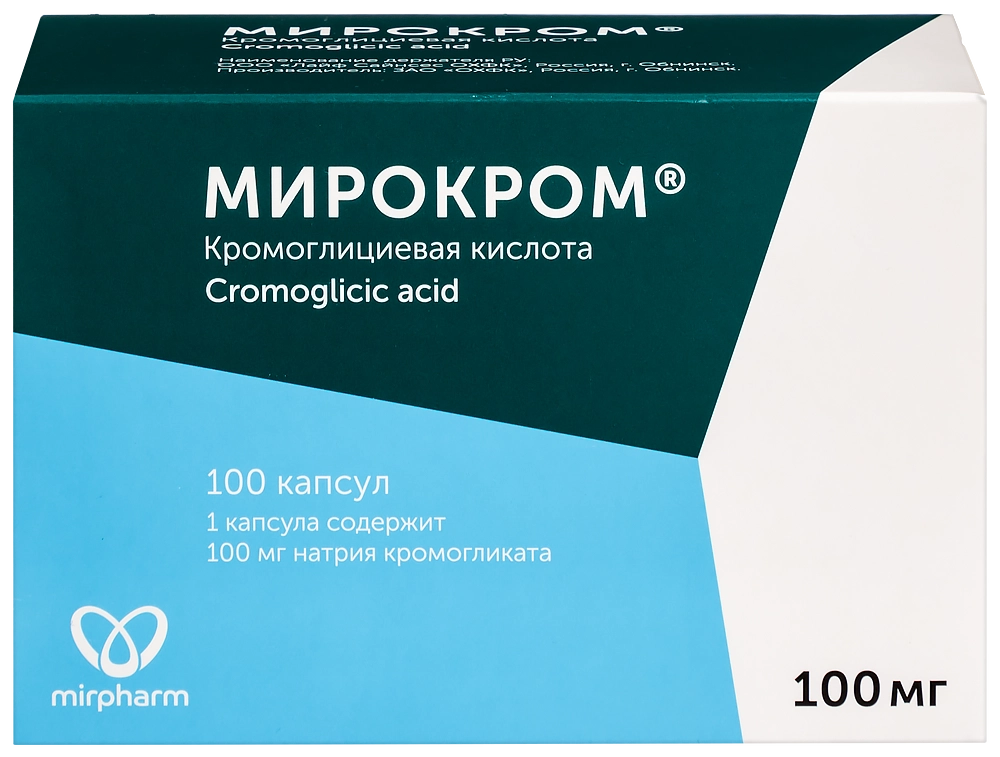No products in the cart.
Description
• Food allergy (with proven presence of an allergen) as monotherapy or in combination with a diet that limits the intake of the allergen; • Non-specific ulcerative colitis (as an adjuvant in combination with glucocorticosteroids (GCS) or sulfasalazine, and also as a drug of choice in patients with hypersensitivity to sulfasalazine).
Instructions
Instructions
The drug is taken orally in the form of capsules or a solution prepared from the contents of the capsules (open the capsule, pour the contents into a glass, pour 1 teaspoon of hot boiled water into the glass, dilute the resulting solution with 2 teaspoons of cold water).
In case of food allergy, 15-20 minutes before meals, adults and children over 14 years old are prescribed an initial dose of 200 mg 4 times a day; children aged 2 to 14 years – 100 mg 4 times a day. The maximum daily dose should not exceed 40 mg/kg.
When a stable therapeutic effect is achieved, the dosage can be reduced to a minimum that ensures the absence of symptoms of the disease.
Patients who for some reason cannot avoid eating food containing allergens should take 1 dose 15 minutes before eating. The optimal dose is selected individually, but within the range
from 100 to 500 mg.
If you accidentally miss a dose of the medicine, you should take it as soon as possible. If this coincides with the next dose, then the missed dose is not taken.
Composition
Composition
Composition per capsule:
Active ingredient: Sodium cromoglycate 100.0 mg
Capsules:
frame:
Titanium dioxide (E171) 2%
Gelatin up to 100%
lid:
Titanium dioxide (E171) 2%
Gelatin up to 100%
Contraindications
Contraindications
• Hypersensitivity to sodium cromoglycate or any other component of the drug;
• Children under 2 years of age.
Use during pregnancy and breastfeeding
During pregnancy (especially in the first trimester), caution should be exercised when prescribing the drug, as well as when prescribing other drugs. The accumulated experience of using the drug during pregnancy confirms the absence of adverse effects of the drug on fetal development. During pregnancy, the drug should be prescribed only in cases where there is an obvious need for its use. It has not been established whether sodium cromoglycate enters breast milk, but based on its physicochemical properties, this can be considered unlikely.
There have been no reports of adverse effects on the infant from the use of sodium cromoglycate by nursing mothers.
Special instructions
Special instructions
Patients with a history of anaphylactic shock or other life-threatening food-induced reactions should not use cromoglicic acid as an adjuvant drug.
The patient should be warned about the need for regular use of the drug.
Impact on the ability to drive vehicles and operate machinery
Not studied.
Side effects
Side effects
Nausea, vomiting, diarrhea, abdominal discomfort, skin rash, joint pain. Allergic reactions are extremely rare.
Pharmacodynamics
Pharmacodynamics
Antiallergic agent, has a membrane-stabilizing effect, prevents degranulation of mast cells and the release of histamine, bradykinin, leukotrienes and other biologically active substances from them. Prevents the development, but does not eliminate the symptoms of immediate-type allergic reactions.
When taken orally in patients with mastocytosis, relief of symptoms from the gastrointestinal tract (diarrhea, abdominal pain) and skin (urticaria, itching) is observed at 2-6 weeks of treatment and lasts for 2-3 weeks.
Storage temperature
Storage temperature
from 2℃ to 30℃
Manufacturer
Manufacturer
Life Science OHFC LLC
Russia
Related products
Buy Mirokrom 100 mg 100 pcs capsules with delivery to USA, UK, Europe and over 120 other countries.














